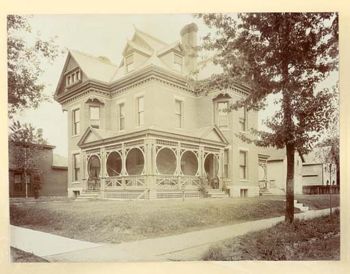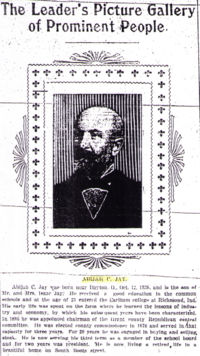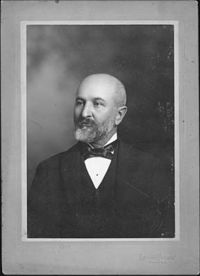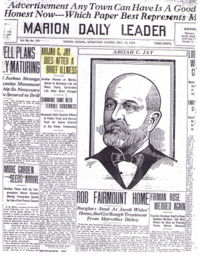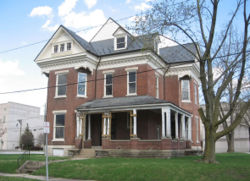Abijah C. Jay House
The Jay House is a red and white two-story Queen Anne-style Victorian home. The foundation of the home is rubble-faced limestone with beaded joints. The walls are of red brick masonry, and the roof is a compound hipped roof with lower cross gables (National Register of Historic Places Registration Form 5). Inside the two-story house, there is a partial basement and an unfinished attic. Although the house was once divided into two apartments, the modifications are minimal. The house retains its original room configuration and all character-defining details on all floors (National Register of Historic Places Registration Form 6).
Contents
Jay's Early Life
Abijah Cooper Jay was born near Dayton, Ohio on October 12, 1838 and was the fourth son of Isaac and Rhoda (Cooper) Jay. The other children were Allen, Milton, Walter, and Mary. Isaac Jay was a farmer and minister of the Friends Church, otherwise known as the Quakers (Abijah C. Jay 1).Isaac and Rhoda Cooper moved their five children to Grant County in 1850 where Isaac purchased a farm located in Center Township. It was 169.16 acres in size, and it kept his family busy. Today, part of the I.O.O.F. Cemetery sits on this site. Abijah’s early life was spent there where he learned lessons of industry and economy (Abijah C. Jay 1).
Abijah was educated at the county schools and later he attended the Academy at Eighth and Adams Streets. At age 21, he entered Earlham College, Richmond, Indiana, and attended for one year. Afterward, he successftilly engaged in the buying and selling of livestock, primarily hogs. Along with this, he farmed and was considered to be a prosperous and leading citizen of Grant County (Abijah C. Jay 1).
Jay's Political Career
Not one to sit back and let the issues of the day pass him by, Abijah became an ardent and warm supporter of the Republican Party. He was elected county commissioner in 1878, the duties of which trust he discharged with marked ability for three years (Brant and Fuller 642). Then, because of his dedication and political savvy, Abijah was appointed chairman of the Grant County Central Committee in 1886 (Brand and Fuller 641).In 1864, Abijah Jay married Miss Caroline Coffin of Richmond, Indiana. They had one son, Cooper. Caroline died in 1880, and their son Cooper later died in 1890. Abijah then remarried in 1881. He took Miss Rhoda Davis of Grant County as his wife. Together, they had one daughter, Florence (Abijah C. Jay 1).
Construction of the Jay House
In 1888, Abijah began construction of his dwelling at 118 West Seventh Street (Abijah C. Jay 2). In the Daily Chronicle, dated March 24, 1888, it stated:
Abijah Jay bought of Jasper A. Gauntt the lot 132 x 66 feet on the corner of Boots and Seventh Street for $2,300. Mr. Gauntt will remove the buildings and during the coming summer Mr. Jay will erect a handsome new brick residence at a cost of five or six thousand dollars (Daily Chronicle 1).
Abijah Jay was going to build his Queen Anne-style home where he would live until his death in what is now downtown Marion.
Jay's Death
Abijah C. Jay’s death occurred on May 18, 1909 at the age of 71 after a brief illness and was buried in the I.O.O.F. Cemetery. He was an active member in the Society of Friends. He was also a member of the Odd Fellows Lodge (Abijah C. Jay 2). He was survived by his wife Rhoda and daughter Florence, one brother, Reverend Allen Jay of Earlham College, and one sister, Mrs. Asa Baldwin of Marion (“A.C. Jay Closes a Prominent Career” 1).Both the Marion Daily Leader and the Marion News-Tribune reported Abijah C. Jay’s death on May 19, 1909(Abijah C. Jay 2). The News-Tribune stated, “Mr. Jay was one of the best-known men in the county (“A.C. Jay Closes a Prominent Career” 1).” The Daily Leader commented that “As a public official, Mr. Jay was well and favorably known (“Abijah C. Jay Dies After a Brief Illness” 2).” During his lifetime, Abijah held several offices of public trust. He served as Commissioner of Grant County for two terms and was in office at the time the present Court House was built; his name appears on the cornerstone. Abijah served on the City Council for seven years. Also, he was county chairman of the Republican Central Committee, and he was a member of the School Board for nine years, retiring in 1907.
Abijah Jay was also President of the Board of Trustees of the Marion Public Library. As President, Abijah wrote a letter to Andrew Carnegie requesting to build a public library in Marion. In the letter, Jay explained where Marion was located in the Gas Belt and how the population had gone from 4,000 fifteen years ago to more than 17,000 at the present time. He also said that more room was needed for the increasing number of books (Jay 1). In the reply to Mr. Jay’s letter, Jas. Bertram, Mr. Carnegie’s private secretary wrote that:
If the city of Marion will provide a suitable site and pledge itself by resolution of Councils to spend from taxation not less than $5,000 a year on the support of its library, Mr. Carnegie will be glad to give $50,000 for the erection of a suitable building (Bertram 1).
As a result Marion’s Carnegie building was built, and Abijah Jay presided at the dedication on December 5, 1902. State legislation in 1903 provided for a new independent Library Board. Although Abijah Jay was no longer involved directly with library governance, his role was extremely significant in achieving the construction of the Carnegie library building at Sixth and Washington Streets (Abijah C. Jay 3).
Restoration
Currently, the Marion Public Library owns the Abijah C. Jay House. Jules Scott Walker, whose family had lived in the house since 1946, purchased the home in 1972. Then in 1991, Walker sold it to Marion Public Library (Grant County 2). The Marion Public Library purchased the Jay House and surrounding property for $65,000. In 1997, the Marion Public Library needed more parking, so if the Jay House was not sold soon, it would be demolished to make room for additional parking (Kightlinger A3). Things changed though and by 1998, the W.K. Kellogg Foundation grant funding the Community History Project gave new vision to use the home as an extension of the library museum, and for meeting rooms and community events. In 1999, the library received a $1,200 grant from the Indiana Preservation Grant Fund for structural analysis. Also in 1999, the library received $2,500 from the Marion Urban Enterprise Association to repair roof supports. In year 2000, the library received a $41,525 grant from the Indiana Department of Natural Resources to help repair the slate roof (Waters Al). On March 27, 2003, the Abijah C. Jay House was listed in the National Register of Historic Places (Goss 1). And now in 2003 and 2004, money that the library itself set aside is being used to install heating and cooling in the building (Israel 1).Today, there is still much work to be done and the renovations continue. In the near future, there is hope that the Jay House will be a thriving adjunct to the Marion Public Library’s Museum as well as an extension of the historical services of the library. The Jay House will also provide additional meeting rooms, space for volunteers, and an office for the community history project (Israel 1). The legend of Abijah C. Jay and his beautiful late Victorian home will live on for other generations to experience.
Works Cited
- Abijah C. Jay. Brochure. Marion Public Library.
- “Abijah C. Jay Dies After a Brief Illness.” Marion Daily Leader 19 May 1909: 1.
- “A.C. Jay Closes a Prominent Career.” Marion News-Tribune 19 May 1909:1.
- Bertram, Jas. Letter to A.C. Jay. Abijah C. Jay Papers. Marion Public Library.
- Brant and Fuller. History of Grant County, Indiana. Chicago: 1886.
- Daily Chronicle 24 Mar. 1888: 1.
- Goss, John R. Letter to Sue Israel. 7 Apr. 2003. Department of Natural Resources Papers. Marion Public Library.
- Grant County. 1 Jan. 2004. www.nxco.net & www.nxco.com. 2 Jan 2004 <www.grantcounty.net>.
- Israel, Sue. Personal Interview. 2 Jan. 2004.
- Jay, A.C. Letter to Andrew Carnegie. Abijah C. Jay Papers. Marion Public Library.
- Kightlinger, Cathy. “Time Runs out for Jay House.” Chronicle-Tribune 25 Sept. 1997: A3.
- National Register of Historic Places Registration Form. National Park Service Form 10- 900. United States Department of the Interior National Park Service.
- Waters, Avon. “Stat Grant Will Help Fund Repair of 113-Year Old House.” Chronicle-Tribune 12 Jan. 2001: Al.
Credits
This paper was written by Zac Mangin in January 2004 as a project for Bill Munn's AP US History Class at Marion High School.
